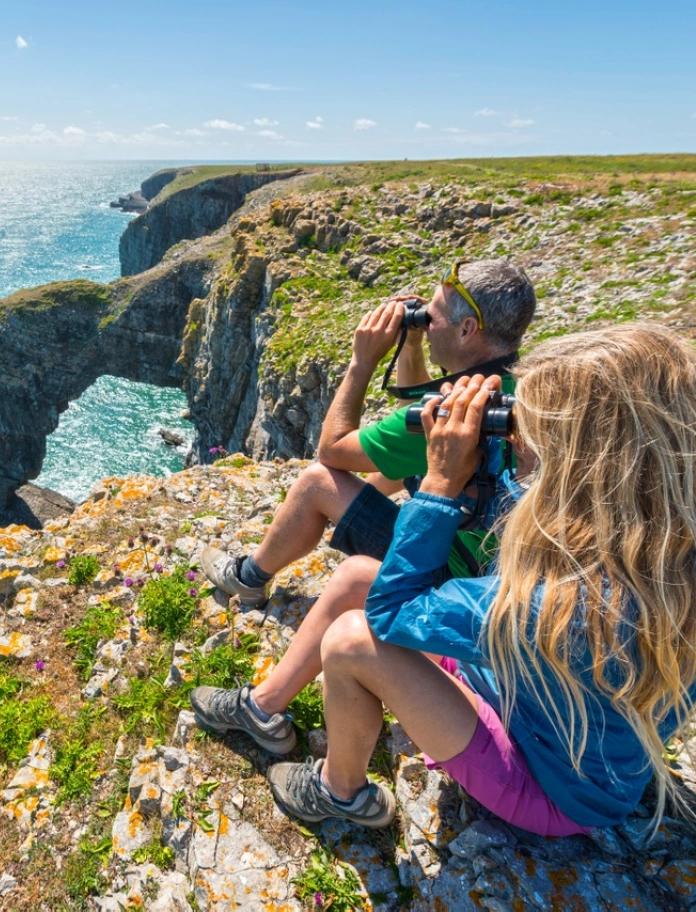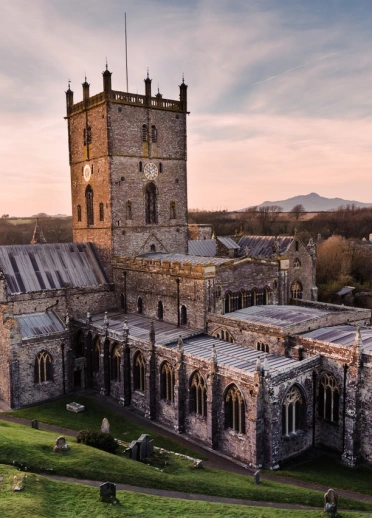One foot in front of the other. Journeying through a majestic coastal landscape. Surrounded by the sights and sounds of the natural world. And, at the end of each day, a new place. The last time I walked the Pembrokeshire Coast Path National Trail, I lost myself in the simplicity of this daily rhythm, forgetting the outside world and revelling in the fresh experiences that came with every twist and turn of the trail.
It was late spring when my partner Heleyne and I caught the train to Aberystwyth and then the bus south to Cardigan (Aberteifi) to set off on our hike. We’d decided to walk the 186 miles (300km) of this stretch of the Wales Coast Path over 15 days, moving on from one B&B or hostel to another most nights, and using a luggage transfer company to transport our baggage. (An alternative option is to hop on and off the buses serving the Pembrokeshire Coast Path. These enable walkers who don’t want to keep moving on to new accommodation each day to select just a few bases and use buses to get to the start and finish points of each section of the walk.)
Wildlife wonders
I’d been to Pembrokeshire at other times of the year, and each of the seasons holds its own delights, but what struck me most on this trip was the wealth of wildlife. We saw dozens of different seabirds, many nesting on cliff ledges, as well as peregrine falcons and rare choughs, known in Welsh as brân goesgoch, literally red-legged crows. Puffins breed on Skomer (Ynys Sgomer) off Marloes Point, and visitors can watch their sometimes comical antics by booking on to one of the Skomer Island landing trips to visit the island nature reserve managed by the Wildlife Trust of South and West Wales.


For a chance of spotting larger creatures, turn your binoculars to the sea. The nutrient-rich waters brought by the Gulf Stream allow seals, porpoises and dolphins to thrive here. It was near the spectacularly located lighthouse at Strumble Head (Pen-Caer) that I heard grey seals barking at each other, apparently bickering for basking space on a couple of rocky islets just offshore. Common dolphins are also frequently seen from this rugged headland and there are occasional sightings of basking sharks, minke whales and even killer whales.

No matter what time of year you visit though, and whatever the weather, the cliffs, bays and beaches never fail to impress. Some of the best beaches include the two-mile-long surfers’ paradise at Newgale (Niwgwl), and the other-worldly Marloes Sands, where scenes for the 2012 fantasy Snow White and the Huntsman were filmed.


Rocky and rugged
With the Ministry of Defence’s Castlemartin firing range open to the public, we were able to enjoy some of the UK’s most fascinating coastal scenery when we reached the southernmost point of Pembrokeshire. Walking east along the cliffs from the Green Bridge of Wales, the sturdy natural arch so popular with photographers, we passed isolated pinnacles of rock rising dramatically from the waves, coves and caves accessible only from the water, and blowholes where we were able to peer down into a cauldron of foaming sea several metres in from the cliff edge. Near the eastern end of this exciting stretch, we discovered St Govan’s Chapel. Cradled by a crevice in the cliffs, this thirteenth-century building was constructed where St Govan, fleeing from pirates, is said to have hidden after a cleft miraculously opened up for him in the rocks.

Ancient heritage
You’ll inevitably come across more stories like this one about the Welsh saints whilst walking the Pembrokeshire Coast Path. This is, after all, said to be the birthplace of St David, the patron saint of Wales. At the western tip of the county, you’ll find places named after his mother, St Non, and his confessor, St Justinian, as well as St Davids (Tyddewi) itself. With a population of less than 2,000, lower than many villages, the latter is the UK’s smallest city.
We decided to slow things down for a couple of days when we reached St Davids. Up until this point, we’d been walking between 11 and 16 miles (18-26km) a day but, because the city lies on a narrow peninsula, we were able to take advantage of the half-hourly Celtic Coaster bus to split another potentially long day in two. More time for ice-creams, watching the surfers at Whitesands Beach (Porth Mawr) and exploring St Davids…

The city’s most famous landmark is its cathedral. Parts of the building that stands today date from the 12th century, but St David first established a monastery here in the sixth century, making this one of the UK’s oldest Christian sites. If you have time to visit, look up! The carved, wooden ceiling is an absolute masterpiece.


Friendly and fascinating
We were able to explore St Davids at a more leisurely pace than many of the other places we passed through, but almost every town, village and fishing cove we visited was friendly and full of character. My personal favourites were the picturesque harbour at Lower Town Fishguard and Tenby (Dinbych-y-pysgod). The latter is best known for its massive sandy beaches, making it popular with holidaying families, but it was an eye-opener to discover the maze of narrow streets and alleyways within the old town walls.


Each day had its own special moments. From the prosaic – tucking in, at Porthgain, to some of the best bara brith I’d ever tasted – to the sublime – being spellbound by the sight of a brilliant red sunset from the YHA’s spectacularly located clifftop hostel at Pwll Deri. These, and many more, are memories we’ll cherish forever.

Useful information
- Before you head out, please read our safety advice for exploring Wales' National Parks and safety tips for staying safe on the Welsh coast.
- Adventure Smart UK has plenty of advice on how to ‘make a good day better’, and we recommend you read it before planning your days out.
- Help Wales become the first Refill Nation by using nearby Refill Points to fill up your water bottle before you head off. Find out more, including how to download the free Refill app to find your nearest Refill Point on the Refill Wales website.






